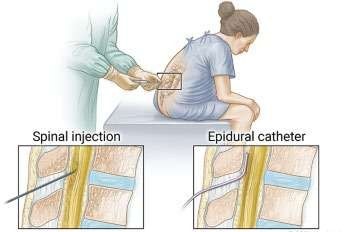A nurse is planning care immediately following birth for a newborn who has a myelomeningocele that is leaking cerebrospinal fluid. Which of the following actions should the nurse include in the plan of care?
Monitor the rectal temperature every 4 hr
Administer broad-spectrum antibiotics
Cleanse the site with povidone-iodine
Prepare for surgical closure after 72 hr
The Correct Answer is B
Rationale for A: Monitoring the rectal temperature is important, but every 4 hours may not be frequent enough to assess for signs of infection or other complications in a newborn with myelomeningocele.
Rationale for B: Administering broad-spectrum antibiotics is crucial to prevent infection, especially in cases of myelomeningocele where the protective covering of the spinal cord is compromised.
Rationale for C: Cleansing the site with povidone-iodine is not recommended as it can be irritating and potentially harmful to the delicate tissue surrounding the defect.
Rationale for D: Surgical closure is typically performed as soon as possible after birth, often within 24 hours, rather than delaying it for 72 hours.
Nursing Test Bank
Naxlex Comprehensive Predictor Exams
Related Questions
Correct Answer is A
Explanation
A common side effect of epidural anaesthesia is a drop in blood pressure. Turning the client onto their side can help improve blood flow to the uterus and baby and may help raise the mother’s blood pressure.

Correct Answer is B
Explanation
Constipation is a common postpartum issue due to decreased bowel motility, dehydration, and fear of pain during defecation. Suppositories are a common treatment option to help relieve constipation in postpartum clients. However, there are certain contraindications to the use of suppositories.
Option A, abdominal distention, is not a contraindication to the use of a suppository, as it can help relieve the distention and promote bowel movement.
Option C, vaginal candidiasis, is also not a contraindication to the use of a suppository. In fact, antifungal suppositories may be prescribed to treat the candidiasis.
Option D, afterpain, is not a contraindication to the use of a suppository, as afterpains are normal
postpartum contractions that occur as the uterus returns to its pre-pregnancy size.
Option B, third-degree perineal laceration, is a contraindication to the use of a suppository. The suppository can cause further trauma to the already injured perineal area and delay the healing process. In this case, alternative treatment options, such as stool softeners or laxatives, should be considered.

Whether you are a student looking to ace your exams or a practicing nurse seeking to enhance your expertise , our nursing education contents will empower you with the confidence and competence to make a difference in the lives of patients and become a respected leader in the healthcare field.
Visit Naxlex, invest in your future and unlock endless possibilities with our unparalleled nursing education contents today
Report Wrong Answer on the Current Question
Do you disagree with the answer? If yes, what is your expected answer? Explain.
Kindly be descriptive with the issue you are facing.
